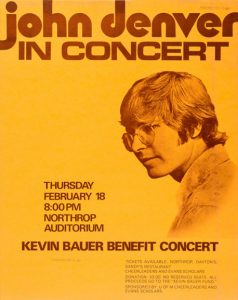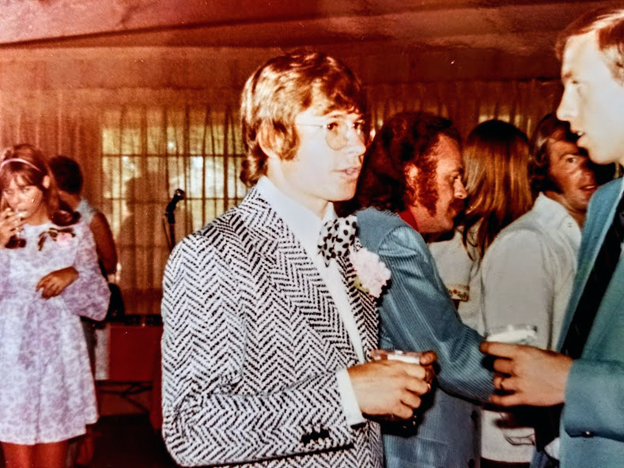Before John Denver became synonymous with Colorado, he had a love affair with Minnesota. It started back in 1966, when he performed with The Chad Mitchell Trio at Gustavus Adolphus College and fell hard for a sophomore art education major in a flannel shirt—Annie Martell, who would later inspire “Annie’s Song.” Denver wrote to Martell three weeks after chatting with her in the student union, and when he returned for a concert at Minnesota State University, Mankato several months later, they had their first date.
As their romance developed, Denver was crisscrossing the country with The Mitchell Trio, but he returned frequently to Minnesota. “I started to hang out with Annie as much as I could and began to think of Minneapolis as home base,” he wrote in his memoir “Take Me Home.” On June 9, 1967—when Denver was 23 and Martell was 20—they married at First Lutheran Church in her hometown of St. Peter.

Courtesy of Heritage Auctions
After a year in Chicago, the couple returned to the Twin Cities, where Martell had friends, and Denver already felt at home. They settled in Edina, renting a unit in the Brookside Court apartments. “I think it says a lot about who we were then that we moved into a staid suburban development rather than a place near the university and its ’60s counter-cultural haunts,” Denver reflected. They listed themselves in the phone book under Denver’s given name, H.J. Deutschendorf Jr., and stayed about three years.
After The Mitchell Trio broke up, Denver launched his solo career by touring college campuses, which included shows at Hamline University, Macalester College, and Concordia University in St. Paul. He also played gigs in other venues around the metro, ranging from Anoka High School’s Snow Days to the downtown Minneapolis Sheraton Ritz Hotel’s Golliwog Lounge, a show that received a glowing review in the Minneapolis Star (now the Minnesota Star Tribune). The locals loved him—tickets went so fast for two shows at the Guthrie in the summer of 1971 that they added a third, which sold out in three hours—and Denver loved them back. One week later, to express gratitude to his adopted hometown fan base, Denver hosted a free reception in Dayton’s eighth-floor auditorium. “Minneapolis, you’re great!” he wrote in an ad he took out in the Minneapolis Star.
“I would like to thank you all personally. Please come up, say hello.”
He continued to express his gratitude by supporting various causes through local performances, including a benefit for a group headed to Paris to negotiate a peace agreement with the North Vietnamese; a benefit for Kevin Bauer, a Gophers cheerleader who broke his neck during cheerleading practice; and an event at the Met Center billed as “the largest peace rally in the history of Minnesota.” Denver also played at former Minnesota governor
Wendell R. Anderson’s inaugural ball in January 1971—the two formed such a close friendship that Denver and Martell asked Anderson to be their son’s godfather.
Denver found inspiration among the state’s multitude of lakes and Scandinavians. He wrote many of the songs for his first four albums while living here, including “Follow Me,” a song he wrote for and performed at the wedding of WCCO celebrities Bill Carlson and Nancy Nelson in 1970. His signature hit, “Take Me Home, Country Roads” was first heard on the radio via WDGY, a local rock ’n’ roll station, after Denver gave a copy of the song to popular disc jockey Johnny Canton.

Photo by Terry Larkin
Like any true Minnesotan, Denver was also influenced by the region’s weather—a single winter day moved him to write four songs, including “Sunshine on my Shoulders.” “It was one of those late-winter, early-spring days,” Denver told the Minnesota Star Tribune’s Jon Bream. “One of those cold, dreary days where everything is gray, yet spring is in fact happening. That’s why the song is slow and melancholy.”
Denver and Martell eventually gave in to the allure of mountains, relocating to Aspen, Colorado, sometime in 1971. By then, however, Denver’s few years in Minnesota had already played a formative, though underreported, role in his career and life; while he may have traded Twin Cities streets for country roads, Denver’s legacy lives on among the likes of Minnesota’s greats.











